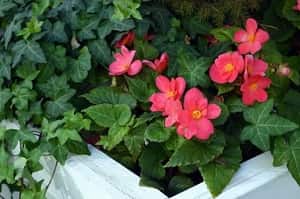Caring for begonias can be done with every inch of success in four ways. First, you have to know where begonias grow best, find the best spot for their growth, provide suitable environmental conditions for them to thrive, and then protect them from infections and infestations.
Keeping begonias in their flourishing form begins with these fundamental steps. But you can take it to a higher level and make them bloom consistently with even simpler steps.
Read on and find out the tips on how to care for begonias allowing them not just to live but become your home’s center of attention.
Table of Contents
Understand Where Begonias Grow Best
Like any other flowering plant, begonias have specific preferences when it comes to location. In terms of hardiness, they grow best in Zones 9 to 11 but can still grow in the colder regions of Zones 2 to 8, provided that they are overwintered indoors.
Matching their versatility to your location allows you to set their living requirements accordingly. For example, you can choose to have them outdoors or indoors. But if you’re living in Zone 5, you should probably just keep them inside.
Begonias, like tropical plants by nature, are perennial. However, since they have become highly adaptable and gardeners continue to provide an optimum environment for them inside during harsh weather conditions, they are often treated as annuals, which means they are tended to grow all year round. So, you still get those striking flowers either way.
Nonetheless, if you happen to live in the right zone, don’t hesitate to fill your garden beds with these beauties and just follow the steps on how to care for begonias.
Choose the Best Spot
In choosing the proper placement for your begonia, consider its exposure to the sun, susceptibility to damage, and the display aesthetic it brings.

Most begonias love to be under the shade than directly below sunlight. But some begonias prefer the other way around. For example, bronze-leaf wax begonias have a high tolerance for strong light and even drought, which means you are free to spread them throughout your garden.
On the other hand, hardy and tuberous begonias with green leaves won’t grow well under direct sunlight. If they don’t have partial or complete shade, you can expect sun damage on their leaves.
When displaying begonias indoors, you can put them near the window for filtered light.
Meanwhile, it’s also imperative to place them high enough so that your children and pets won’t reach and accidentally ingest the leaves. Begonias are not fatal when eaten, but can cause vomiting, salivation, and digestive distress.
In designing your garden or indoor collection, consider pairing your begonias hostas, bergenia, or summer bulbs to achieve that cascading flower effect.
Provide Their Growth Requirements
The fundamental needs of begonias should never be taken for granted. Before you buy or plant the cutting, make a checklist containing the following:
- Soil Requirements: Well-drained, sandy loamy, and moist
- Sun Requirement: Partial shade; avoid placing the begonia under direct sunlight
- Watering Schedule: Water the begonias every two to four days when young; then every other week as they grow
- Humidity: At least 40% to 50%
- Temperature: Daytime 75 degrees Fahrenheit; Nightime 63 to 65 degrees Fahrenheit
Understanding how to propagate and grow begonias lead to satisfying rewards of flourishing blooms. Stick to what they need, and you can easily set up their optimum environment to thrive.
Protect Your Begonias From Pests and Diseases
Begonias have natural ways to protect themselves from damage considering the leaves contain oxalic acid, which is toxic to most leaf-eating insects. However, other types of pests still get through and feast on the entire plant itself, such as aphids, spider mites, earwigs, caterpillars, slugs, snails, scales, and whiteflies.
If you find holes in your begonia leaves, the said insects could be the culprit. Spray some organic insecticide to preserve your begonia’s beauty.
On the other hand, fungi like mildew can also destroy your begonia. Luckily, you can get rid of the infestation by spraying a solution of 1 teaspoon of baking soda and a quart of water. Then, spread it all over the leaves’ surface.
Additionally, make sure to disinfect all the tools you use for pruning or propagating begonias. Use a bleach solution and spray or wipe it on the items.
3 Tips To Keep Begonias Blooming
Begonias can survive various conditions, but making them flourish requires a bit of work. Nonetheless, the effort you need to exert isn’t too taxing.
Part of the key steps on how to keep begonias blooming include pruning and trimming the plant properly, applying fertilizer, and repotting them when they get too big.
Prune Begonias the Right Way
Trimming begonias and pinching new leaves encourage healthier growth. As a result, it produces denser foliage and showy flowers, allowing it to bloom and look rich. But when and how to prune your begonias depend on the need and timing.
Home gardeners usually do their trimmings in spring as the weather becomes best for new leaves to grow. However, you may not want to wait for spring if the leaves and flowers look pale, damaged, or discolored.
Add Sufficient Fertilizer
If you aim for luscious foliage and consistent bloom, add fertilizer to your begonias every two weeks during the flowering period. The supplementary nutrients promote faster and more robust growth.
Gardeners use high-nitrogen and low-nitrogen fertilizers for begonias alternately to produce vivid high-bloom flowers. You can also use compost or granular fertilizer, especially during the growing period when the begonias are still young.
During winter, you can forego fertilizing, especially if you intend to keep them inside for housing purposes. Begonia’s care indoors includes providing a space for the plants to stay dormant during colder months.
Repot When Their Roots Fill the Pot
When your begonias grow too big with rich roots cramping in a small pot, that’s more than enough signs that you need to do repotting. Otherwise, they may have trouble growing as the roots overfill the container, affecting their ability to produce striking flowers.
Repot your begonias after three years or the moment they have overgrown in the pot. But make sure you meet all the growth requirements to avoid your begonias experiencing stress or shock.
Frequently Asked Questions
How Do You Keep Begonias Over the Winter?
To ensure begonias survive the winter, you will have to bring your begonias outdoor inside your home for overwintering.
Overwintering begonias involve pulling them from the bedding, then placing the clumps in newspapers and leaving them to dry near an area inside your house accessible to sunlight. After a week, transfer the clusters to paper bags and put them in a box in a cool, dry location.
When spring comes, you can replant the begonias back to your garden and prepare them for the flowering period.
For begonias in pots, you can simply keep them the way they are, but they should be placed in a secured area or room. Keep them upright and check on the soil’s moisture.
What Do Overwatered Begonias Look Like?
Overwater begonias have soft and limp leaves, and the tips turn brown. The foliage, as a whole, looks mostly yellow and will eventually fall off. You may also observe your begonias wilting with brown spots which could suggest root rot due to waterlogged soil.
Furthermore, fungal growth on the soil pretty much indicates overwatering as they thrive in consistently moist soil. Check the topsoil for molds, usually with gray thread-like coverage.
How Do You Save an Overwatered Begonia?
To save a begonia that has been waterlogged, you have to carefully take the plant out of the soil and inspect the roots. Cut off parts that appear to be black, brown, soft, or mushy leaving the healthy portion for repotting. Sterilize your tools first using a bleach solution.
Next, replant the begonia in well-drained soil. For maximum chances of survival, apply fungicide to the soil. Place the plant in an area reached by indirect sunlight and only water it after a week to allow the roots to recover and adjust to their new soil environment.
Are Coffee Grounds Good for Begonias?
Putting coffee grounds directly on your begonias generally doesn’t end up well. While they may be a source of nitrogen, an element that encourages high flower bloom, coffee grounds are also highly acidic causing damage to your begonia’s health. It also encourages fungal growth which could destroy your plant altogether.
Gardeners suggest adding coffee grounds to compost to produce organic fertilizers. But if you don’t possess the expertise to produce homemade fertilizers properly, better stick to nutrient-rich soil mixed with peat moss or fertilizers sold in your local shops.
Final Thoughts
Begonias are known to be low-maintenance, making them a must-have for novice gardeners. Their reputation is supported by the fact you don’t need tons of tools, time, and effort to care for them. Plus, you can let them bloom to their best capacity through practical and less demanding ways.
Follow all the tips discussed in this article and you’ll find yourself with begonias in their optimum health.
Recent Posts
Have you found yourself wondering, 'why is my bamboo growing so slow?' Despite the fact that bamboo plants are remarkably fast-growing, it can sometimes take months (or even years!) to see any signs...
Miracle-Gro is a huge help when you are trying to get decent yields out of your plants or if you want them to thrive. However, you may have noticed that a single dose of fertilizer does little to...
